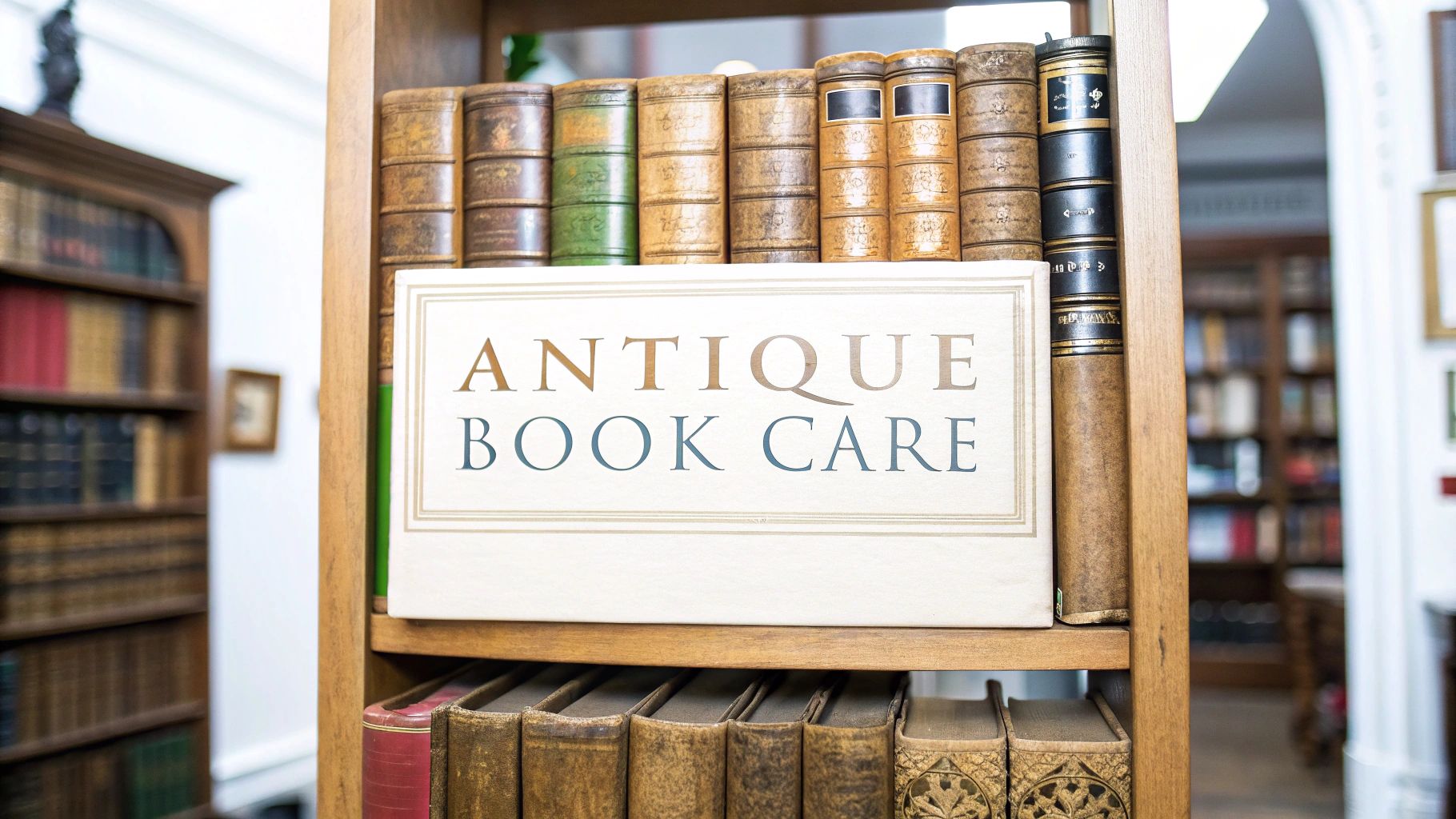Properly storing your antique books comes down to controlling their environment. You're fighting a constant battle against light, moisture, and temperature swings. The best way to win is by using acid-free materials, keeping the climate stable at around 65-72°F and 45-55% humidity, and using smart shelving and handling techniques to avoid physical damage.
Your Foundation for Preserving Antique Books
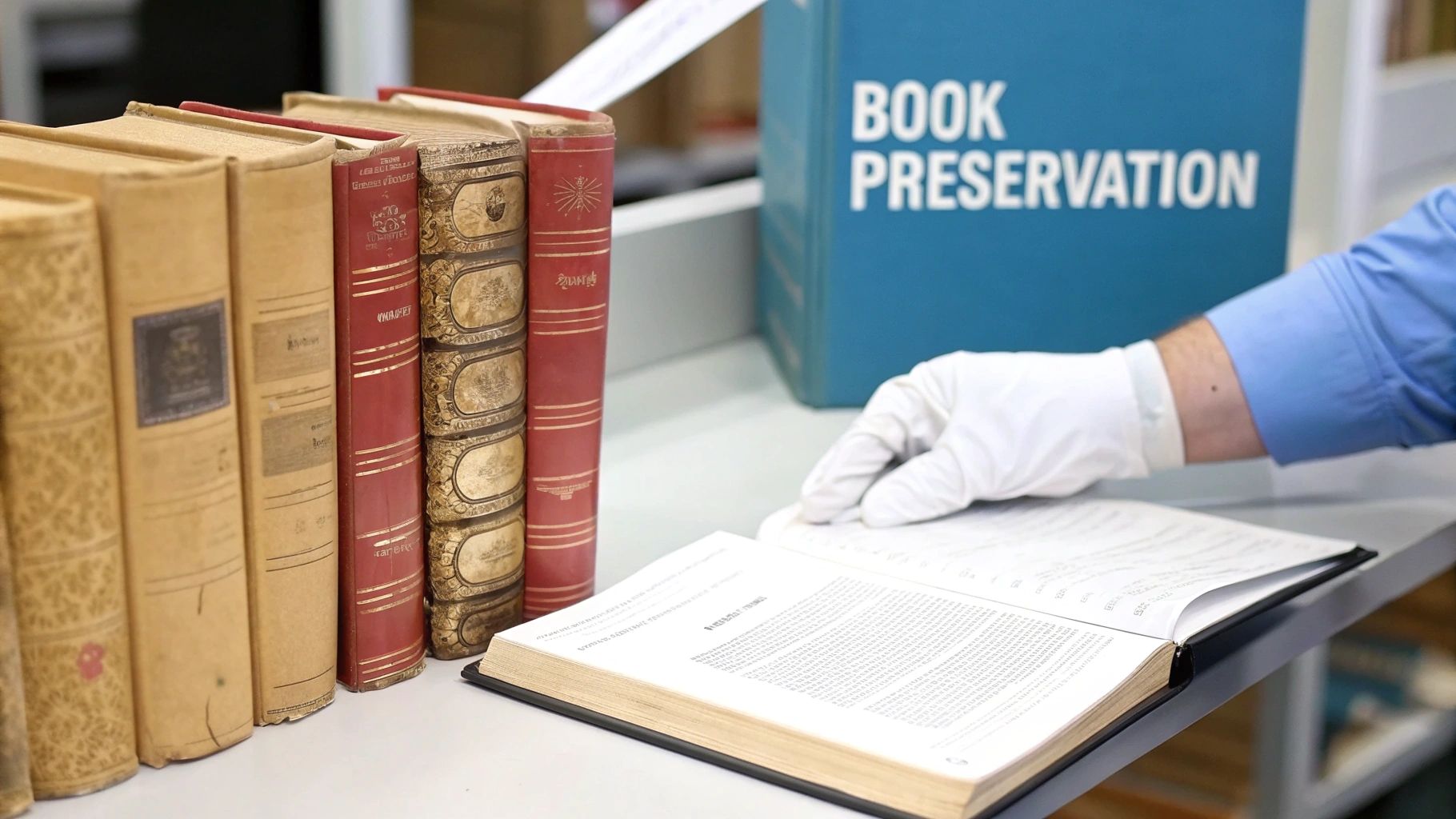
Before you even think about putting a book on a shelf, let's talk about the fundamentals. This is the single most important part of protecting your collection. These aren't just old books; they're delicate artifacts. The paper, leather, cloth, and glues are all incredibly sensitive to their surroundings and will break down if you're not careful.
The thrill of finding a new piece for your collection is immense, but learning how to care for it is what makes you a true collector. If you're just starting out, our guide on https://www.curio.app/blog/antique-collecting-for-beginners offers some great perspective. Your main job is to create a safe, stable home for your books to slow down the aging process as much as humanly possible.
Key Preservation Principles
Think of your storage strategy as a shield against the enemies of old books: light, pests, a chaotic climate, and clumsy handling. All these elements work together. If you get one wrong, it can sabotage all your other efforts.
For instance, that gorgeous antique oak bookshelf might look perfect, but the acid in the wood can actually "migrate" into the paper, making it brittle over time. A dark, dry room seems ideal, but if it's a basement that gets damp in the spring, you're rolling out the welcome mat for mold—a book's mortal enemy.
Here are the cornerstones we’ll build on:
- Environmental Stability: Consistent temperature and humidity are non-negotiable.
- Material Selection: Always choose archivally-safe, acid-free products to prevent chemical burns and decay.
- Correct Handling: A few simple techniques can be the difference between a healthy spine and a broken one.
- Physical Support: The right shelving ensures a book isn’t slowly being destroyed by its own weight.
Preserving an antique book is less about restoration and more about prevention. Your primary role as a collector is to be a custodian, protecting the item from further harm so its history can be enjoyed by future generations.
Sometimes, a home environment just isn't right, or a collection simply gets too big. In those cases, professional off-site storage is a great solution. If you're considering this, understanding the factors involved in renting external storage is a must-read to ensure you're asking the right questions about climate control and security.
Common Threats to Antique Books and How to Prevent Them
To give you a clear roadmap, I've put together a quick summary of the biggest dangers your antique books face. Think of this as your cheat sheet for mastering the basics. Get these right, and you've built a strong foundation for a long-lasting collection.
| Common Threat | Primary Cause | Essential Preventive Action |
|---|---|---|
| Light Damage | UV rays from sunlight and fluorescent lighting | Store books away from windows; use UV-filtering film or shades. |
| Mold & Mildew | High humidity (above 60%) and poor air circulation | Maintain relative humidity between 45-55% with a dehumidifier. |
| Brittleness | Acidic paper, high heat, and low humidity | Keep temperatures stable and avoid attics or uninsulated areas. |
| Spine Damage | Improper removal from shelves or poor support | Grasp books by the sides, not the top of the spine; use bookends. |
Tackling these common issues head-on is the best defense you can mount. By controlling these factors, you're not just storing books—you're actively preserving a piece of history.
Creating the Ideal Environment for Your Collection
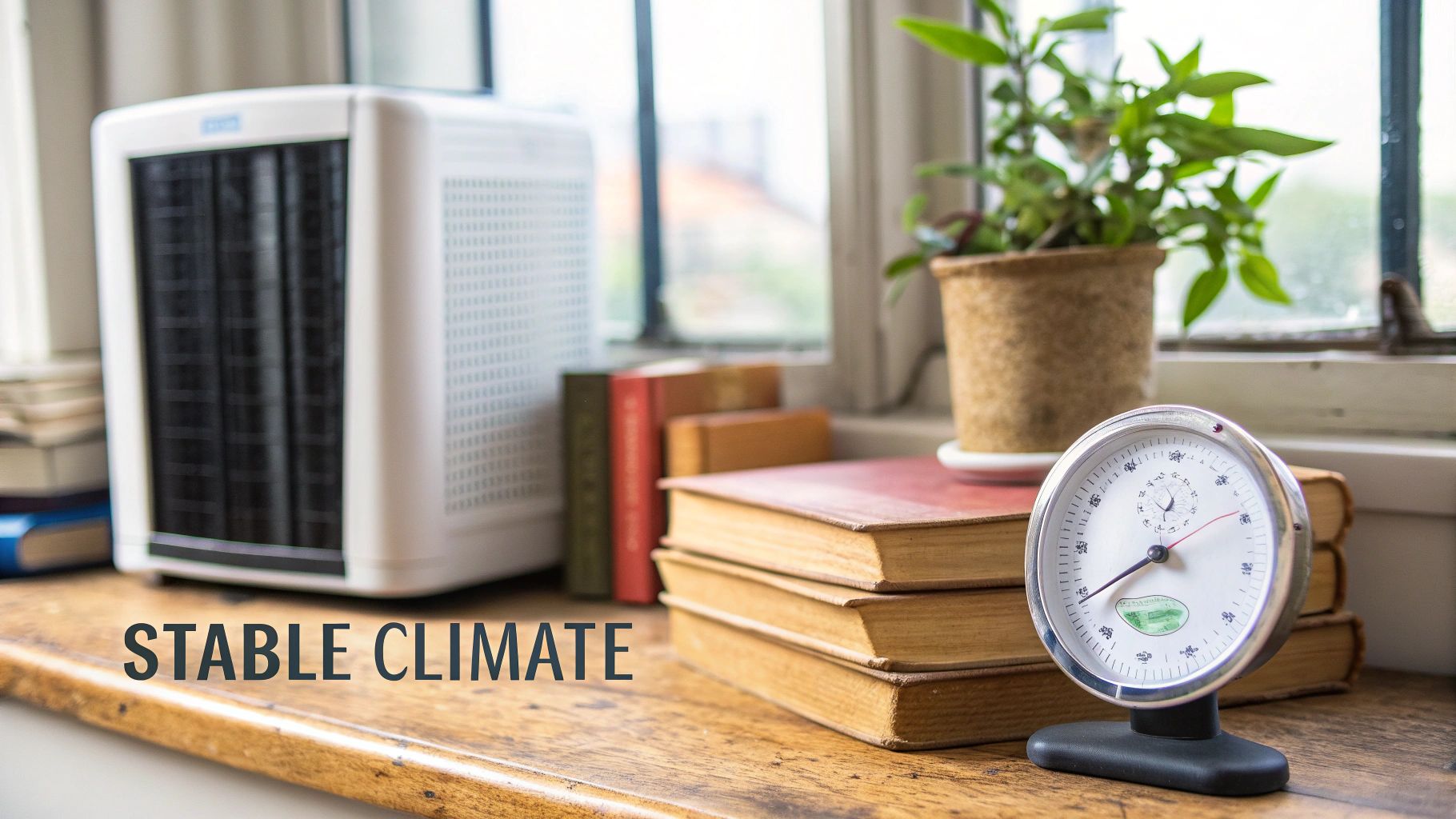
If there's one piece of advice I stress above all others, it's this: master the environment. Think of the room where you keep your books not just as a storage space, but as an incubator designed to dramatically slow the aging process.
Antique books are incredibly reactive to their surroundings. The old paper, leather, and glues are in a constant, subtle state of flux, expanding and contracting with every shift in temperature and humidity. Over time, this causes paper fibers to weaken, bindings to crack, and pages to turn brittle. Your greatest weapon against this decay is consistency.
Temperature and Humidity: The Two Pillars of Preservation
When it comes to preserving old books, think cool and dry. You're aiming for a steady temperature somewhere between 65-72°F (18-22°C). This range is cool enough to inhibit chemical decay but warm enough to be practical for most homes.
Humidity is the other, equally critical, piece of the puzzle. The sweet spot for relative humidity is between 45-55%. Go much higher, and you're rolling out the welcome mat for mold, which will happily consume paper and leave irreversible stains. Go too low, and you risk drying out leather and adhesives, making them fragile and prone to crumbling.
Getting this right isn't complicated. A few simple tools will do the trick:
- A Digital Hygrometer: This is your best friend. It’s a small, inexpensive gadget that measures both temperature and humidity. Stick one on a shelf with your books and check it periodically to get a feel for your room's natural rhythm.
- A Dehumidifier: If you notice your humidity levels are consistently creeping above 60%, a dehumidifier is a fantastic investment. It works automatically to pull that destructive moisture right out of the air.
- Good Air Circulation: Even a small fan on a low setting can work wonders. It keeps the air moving and prevents stagnant pockets where mold loves to get started.
The real killer for antique books isn't usually a single catastrophic event. It's the slow, cumulative stress from daily and seasonal fluctuations. A stable environment, even if not absolutely perfect, is far better than one that's constantly swinging from one extreme to another.
Keeping moisture in check is a huge part of protecting your collection. You can find more strategies for preventing mold in your home that will safeguard not just your books, but your entire living space.
The Invisible Threat of Light
Light, especially direct sunlight, is one of the fastest and most destructive forces your books will face. Its UV rays act like a persistent bleach, fading ink, yellowing paper, and causing leather bindings to lighten and break down. The worst part? This damage is cumulative and completely permanent.
The easiest solution is to simply keep your collection out of the sun. An interior room or even a well-ventilated closet is perfect. If your books have to live in a room with windows, take these steps to protect them:
- Install UV-filtering film on the window panes. It's nearly invisible and blocks the most harmful rays.
- Keep curtains or blinds drawn, particularly during the sunniest hours of the day.
- Whatever you do, don't place your bookshelves directly in a sunbeam or opposite a window.
These same principles for fighting light and moisture damage also apply to other fragile paper heirlooms. If you're also protecting old family pictures, you'll find our guide on https://www.curio.app/blog/how-to-preserve-old-photographs offers some closely related advice.
Mastering Shelving and Handling Techniques
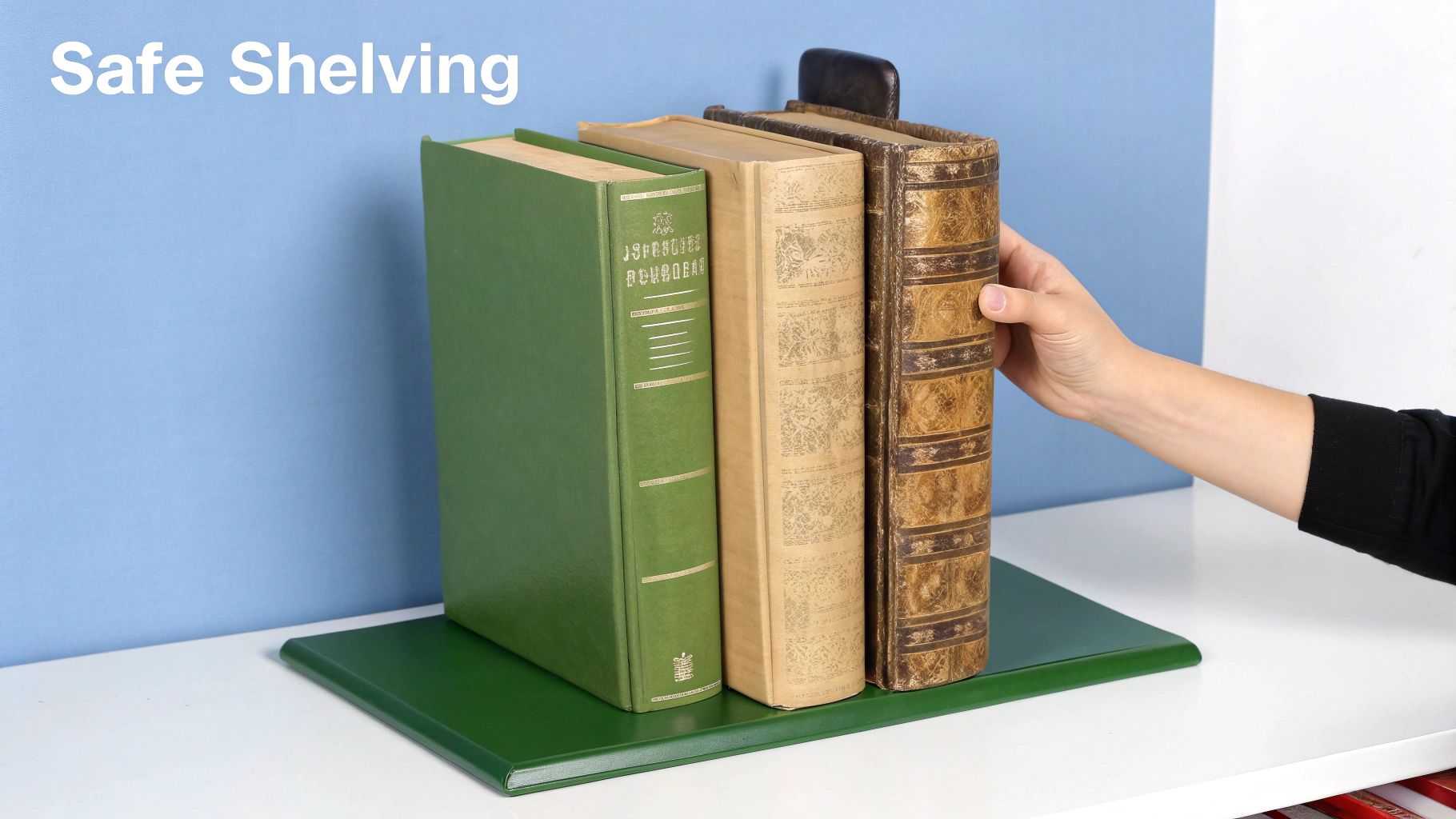
Beyond just controlling the environment, how you physically store and handle your books can mean the difference between long-term preservation and slow-motion destruction. The way a book sits on a shelf day after day determines the stress on its spine and pages. Getting this right is one of the easiest, yet most critical, parts of your preservation strategy.
A simple but powerful rule of thumb is to group books of similar size together. This ensures the pressure between them is even, preventing a massive tome from warping or damaging its smaller neighbor. You're essentially creating a stable, supportive community on your shelf where no single book bears an undue burden.
Proper Shelving Practices
For most antique books, the best position is standing upright. The key, however, is to make sure they aren't leaning. A leaning book puts constant, uneven strain on its binding, which can eventually cause the text block to pull away from the cover.
You want your books to be snug but not crammed. A good test is whether you can easily slide a single book out without disturbing its neighbors.
Here are a few practical tips to follow:
- Use Proper Bookends: Invest in some smooth, sturdy, archival-quality bookends. They provide the gentle support needed to keep a row of books standing perfectly straight.
- Don't Overcrowd: It's tempting to squeeze one more book onto a shelf, but this is a classic mistake. It causes abrasion every time you remove a book and puts immense pressure on the spines.
- Lay Large Volumes Flat: If you have an oversized or exceptionally heavy book—think old atlases or art folios—the safest way to store it is lying flat. Storing it vertically puts far too much stress on the binding. Just be sure to limit your stacks to two or three volumes to prevent crushing the book at the bottom.
A detail many collectors miss is the shelf material itself. Untreated wood, particularly oak, can be highly acidic and leach damaging chemicals into your books over time. If you have wooden shelves, make sure they’re sealed with a water-based polyurethane varnish to create a safe barrier. You can learn more in our guide on cleaning antique wooden furniture.
The Gentle Art of Handling
Every single time you pick up an antique book, you have a chance to either protect it or cause harm. The most common mistake I see is people pulling a book from the shelf by tugging on the top of its spine—the part we call the headcap. This is often the most fragile part of the binding and can tear with surprising ease.
Instead, get into this simple habit:
- Push the books on either side of the one you want back about an inch.
- This creates enough space to get a good grip on your book from the middle of its sides.
- Carefully pull the book straight out.
It’s a tiny change that dramatically reduces wear and tear over the years. Poor shelving and handling really do add up. One study found that bad storage practices, like overcrowding and using damaging bookends, were responsible for damage in nearly 9% of the books surveyed. If you’re interested in the details, you can read the full research on archival storage practices.
Using Protective Enclosures for Fragile Books
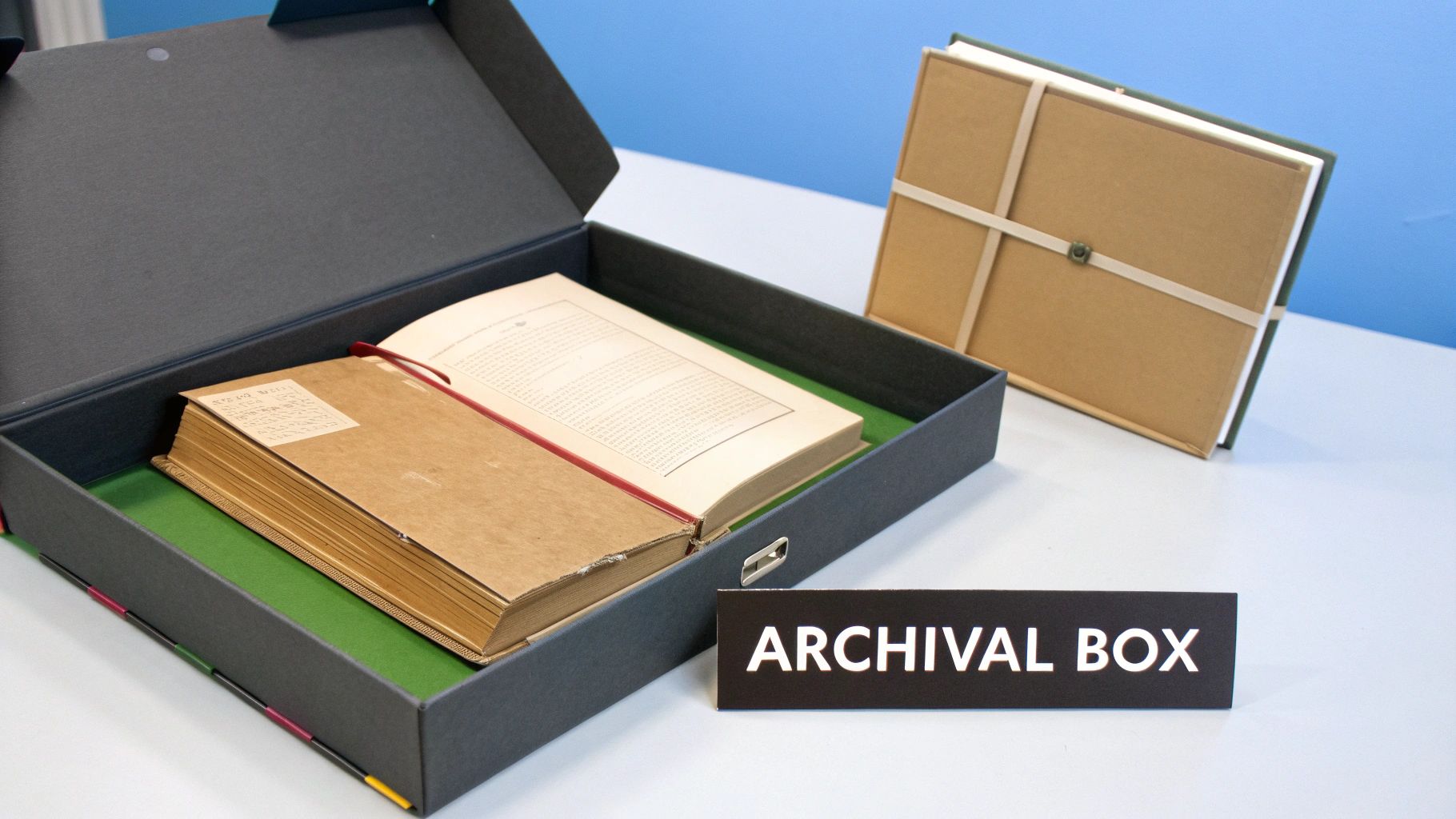
For your most valuable, fragile, or sentimentally important books, you need an extra layer of defense. I like to think of a protective enclosure as a custom-fit suit of armor, not just a box. It creates a stable micro-environment that shields the book from dust, light, and the inevitable bumps and scrapes of daily life.
This becomes especially critical for books already showing their age. A well-made case physically holds a book together, preventing further deterioration and making sure all its parts—like a detached cover or loose pages—stay together as a single unit.
Choosing the Right Materials
Here's the golden rule: only use archival-quality materials. This is non-negotiable. It means any paperboard, cloth, or glue used must be both acid-free and lignin-free. Lignin is a natural compound in wood pulp that breaks down over time, releasing acids that make paper yellow and brittle.
Using a standard cardboard box is like storing your book in a slow-acting acid bath. It will actively damage the very item you're trying to protect. Always look for products specifically labeled for archival storage. This ensures they are chemically stable and perfectly safe for long-term contact with your collection.
Common Types of Protective Enclosures
Not every book needs the same fortress-like protection. Your choice really depends on the book’s condition, its value, and how often you plan to handle it.
- Archival Folders and Wrappers: These are simple, cost-effective options perfect for pamphlets, thin volumes, or books with bindings that are still in good shape. They just wrap around the book, offering solid protection from dust and light on the shelf.
- Slipcases: This is a five-sided box that leaves the book's spine exposed. They look fantastic on a shelf but are best for books in near-perfect condition. Constantly sliding the book in and out can cause friction damage to the spine and corners over time.
- Clamshell Boxes: This is the gold standard for book protection, hands down. A clamshell box is a custom-fit, two-piece container hinged together. It opens flat, presenting the book safely for you to remove. It offers complete protection from light, dust, and physical impact.
A scenario I see all the time is a 19th-century leather-bound book with a detached front cover. Storing it loose on a shelf is just a disaster waiting to happen. A custom-made clamshell box is the ideal solution here. It keeps the loose cover safely paired with the text block, preventing any further damage or loss.
The Practical Trade-Offs
Protective enclosures are proven to dramatically extend the life of antique books by buffering them against environmental shifts. We have plenty of research showing that archival boxing can stop degradation from humidity and light, preventing covers from warping and loose leaves from detaching.
The trade-off, however, is space. Boxing a full collection can increase your shelving needs by up to 30%, which is a huge consideration for collectors with limited room. You can find more great insights on the benefits of archival housing on ccaha.org. Even with the space issue, the superior protection and safer handling you get from a good box are almost always worth the extra real estate.
Building a Long-Term Maintenance Routine
Getting your antique books properly stored is a huge first step, but the job isn't quite done once they're on the shelf. The real secret to keeping a collection healthy for the long haul is a simple, consistent maintenance routine. We're not talking about complex restoration work here. This is about gentle, regular care that stops tiny issues from turning into major, irreversible damage.
Think of it like tending a garden. You wouldn't just plant the seeds and hope for the best. It's the small, ongoing effort that allows your collection to truly thrive for generations.
Gentle Cleaning and Dust Removal
Dust looks harmless, but it's a real enemy to old books. It’s abrasive, holds moisture, and can be a magnet for mold spores. One of the best preventative measures you can take is also one of the simplest: regular, gentle dusting.
The most important rule is to never use liquids or commercial cleaning products. I've seen beautiful bindings permanently stained by well-meaning owners using furniture polish, waxes, or even just a damp cloth. Your only goal is to remove loose surface dust, nothing more.
All you need is a soft, natural-bristle brush—something like a goat-hair brush works perfectly. With a light touch, just brush the dust away from the spine, starting at the top of the book and working your way down. Doing this every few months is enough to keep grime from building up and becoming a much bigger problem.
Vigilant Pest Prevention
I can't stress this enough: nothing will destroy a collection faster than pests. Insects like booklice and silverfish absolutely love the starches and glues in old bookbindings. They thrive in the exact dark, quiet, and sometimes humid places we often keep our books.
Your best defense is being watchful. When you're doing your routine dusting, take an extra minute to inspect your books for signs of trouble.
- Look for "frass": This is a fine, powdery substance that is basically insect waste. You’ll often find it along the spine or in the gutters between pages.
- Check for tiny holes or channels: These are tell-tale signs of bookworms or other insects boring into the paper or binding.
- Watch for movement: Silverfish are quick, silvery little insects. You might catch one scurrying for cover when you move a book.
If you even suspect an infestation, the first thing you should do is isolate the book in a sealed plastic bag. This keeps the problem from spreading to its neighbors. For anything more than a single bug, your safest bet is to consult a professional book conservator.
Preservation is an ongoing process, not a one-time project. A simple annual check-in can catch environmental drift or early signs of decay before they cause permanent harm, making your care plan feel manageable rather than overwhelming.
Your Annual Preservation Checklist
Once a year, it's a good idea to set aside an hour for a more thorough health check on your collection. This helps you make sure your storage environment is still stable and that the books themselves are in good shape.
- Review Environmental Data: Take a look at the logs from your hygrometer. Have you seen any big swings in temperature or humidity? If so, try to figure out why—it could be a seasonal shift or a problem with your HVAC system that needs attention.
- Inspect for Mold or Mildew: Carefully check books for any fuzzy spots (they can be white, black, or green) or a distinct musty smell. I always pay extra attention to books stored near outside walls, as these areas can be prone to dampness.
- Check Shelf Stability: Make sure your shelves are still level and not starting to sag. It happens. Tighten any loose screws or brackets. Also, take a peek to ensure your books aren't jammed in too tightly, which is an easy mistake to make as a collection grows.
- Rotate and Re-Shelve: If you can, gently rotate some of your books. This helps relieve the constant pressure on the spines, especially for heavy volumes that have sat in the same spot for years. It's also the perfect time to make sure there’s still good airflow around your collection.
Have a Few More Questions?
Even after you've got the basics down, you're bound to run into specific challenges. It's one thing to read about ideal humidity levels, but it's another thing entirely when you’re standing in a store wondering if a certain plastic bin is a good idea. Let's tackle some of the most common questions I hear from fellow collectors.
These are the real-world dilemmas that pop up. When you've just brought home a new find that smells a bit off, or you're trying to pick out the right bookshelf, you need practical answers, fast.
Can I Store Old Books in Plastic Containers or Bags?
This is a really common question, and my advice is almost always to steer clear. It seems like an easy solution, but most plastics can be a nightmare for old books. They trap moisture, which is an open invitation for mold, and many plastics "off-gas" harmful chemicals that can make paper brittle and yellow.
If you're in a pinch and absolutely have to use a container, make sure it’s made of an archival-quality plastic like polypropylene. And here's the most important part: never seal it airtight. Books need to breathe. Leaving the lid slightly ajar or using an unsealed bag allows for crucial air circulation and prevents that dangerous moisture buildup.
Honestly, a simple acid-free cardboard box is a much safer temporary home. It keeps the dust and light off without turning into a humidity trap. I’d choose that over a sealed plastic bin any day of the week.
What Is the Best Type of Bookshelf for Antique Books?
For a long-term, worry-free solution, powder-coated steel is the gold standard. It’s strong, it's stable, and it won’t release any chemicals or acids that can damage your collection over time.
Of course, many of us love the classic look of wood. If you go that route, just be careful. Pick a good, stable hardwood and—this is critical—seal it with a water-based polyurethane varnish. This creates a protective barrier between your books and the natural acids in the wood. Just be sure to let the varnish cure for a few weeks before you even think about putting books on it, so all the fumes have a chance to dissipate. Whatever you do, stay away from particleboard or MDF; the adhesives they're made with are incredibly damaging to old paper.
How Do I Deal with a Musty Smell in an Old Book?
That classic "old book smell" can sometimes be something more sinister. A musty odor is usually a red flag for mold, either past or present. Your first move should be to carefully inspect the book. Gently fan through the pages and check the binding for any fuzzy spots or discoloration.
To tackle the smell itself, you can try setting up a simple odor-absorbing chamber. Find a large container and place the book inside along with an open dish of baking soda or activated charcoal. Make sure the absorbent material never touches the book directly. Let it sit for a few days (or even a few weeks for a stubborn smell), but ensure there's still a bit of air circulation. If the smell is really strong or you see active mold, it's time to call in a professional. Isolate the book from the rest of your collection and consult a book conservator for proper treatment.
Found a unique piece in your collection and wondering about its history or value? Curio acts like an antiques expert right in your pocket. Just snap a photo to get instant identification, fascinating historical details, and an estimated appraisal for your treasures. Uncover the story behind your antiques today!
